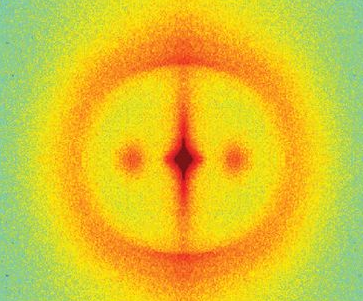Diagnosing GAN one strand at a time

Giant axonal neuropathy (GAN) is an extremely rare genetic disease with only 73 known patients worldwide. GAN causes a gradual failure of motor neurons that stimulate muscles and eventually failure of sensory neurons. New research, published recently in Journal of the Royal Society Interface, offers a novel way of diagnosing the disease. The work was led by Professor Maikel Rheinstadter who runs an experimental biophysics lab at McMaster University.
GAN is caused by a genetic mutation in the GAN gene, which codes for the protein gigaxonin. This alters the structure and degradation of gigaxonin and its interaction with other proteins, resulting in the accumulation of intermediate filaments (cytoskeletal components of cells) along the axons of nerve cells. These enlarged or 'giant' neurons cannot transmit signals properly and eventually deteriorate.
Patients typically show low muscle tone, muscle weakness, decreased reflexes, impaired muscle coordination, seizures and intellectual disability, and often also have tightly curled hair. It's this last phenotype that intrigued Maikel and his colleagues – they wanted to understand the connection between GAN and its common curly haired symptom.
The authors used X-ray diffraction and tensile testing to compare scalp hair from GAN patients with hair from control subjects. They discovered that GAN, in addition to axonal filament accumulation, also alters the structure of keratin proteins within human hair. This structural change also had effects on the mechanical properties of hair; it was slightly stiffer, stronger and more extensible in GAN patients.
Diagnosis of GAN is difficult and includes nerve conduction velocity, brain MRI and peripheral nerve biopsy, and eventually genetic testing for abnormalities in the GAN gene. What Maikel and colleagues have shown is a much easier way of testing for GAN to help patients find the right diagnosis much sooner. Professor Rheinstadter comments:
"One of the big problems is that because GAN is so rare, it is often misdiagnosed and patients often go through a diagnostic odyssey before they find help. Our techniques are non-invasive, inexpensive and well suited as high throughput screening techniques. They simply involve collecting a few strands of hair from potential GAN patients."
The authors have used these techniques before to show that there are also structural abnormalities in the hair of patients with novel ribosomopathy, another very rare genetic defect where patients also have curled hair as an associated phenotype.
More information: Asfia Soomro et al. Giant axonal neuropathy alters the structure of keratin intermediate filaments in human hair, Journal of The Royal Society Interface (2017). DOI: 10.1098/rsif.2017.0123
Richard J. Alsop et al. Structural Abnormalities in the Hair of a Patient with a Novel Ribosomopathy, PLOS ONE (2016). DOI: 10.1371/journal.pone.0149619


















